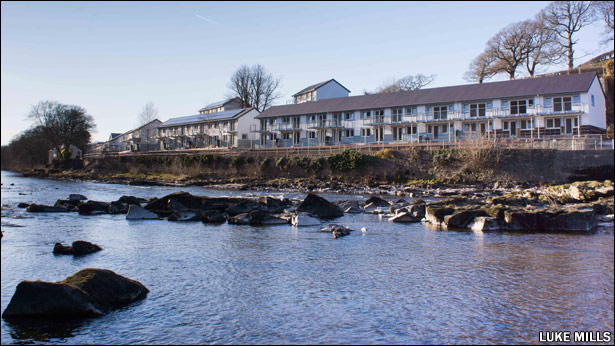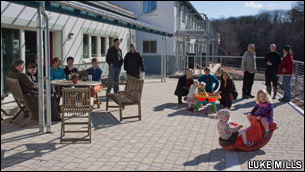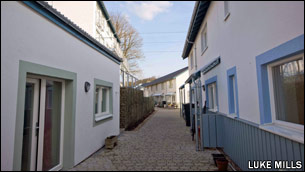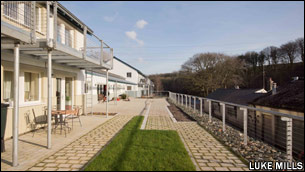
17 November 2013
A 41 home highly sustainable cohousing project near Lancaster has won the self build sector’s top award for 2013.
The Award (called the Murray Armor Award after the acclaimed self build author who died in 1998) is not so much about the look of the project as it is about the commitment and tenacity of the people who planned and constructed it.
{TEASER}
This is the first time the award has gone to a collective self or custom build project.
The Lancaster Cohousing scheme provides private homes with communal space and sits on the bank of the River Lune at Halton. It has taken seven years to deliver – with the initial group first coming together in 2004. A Cohousing development is created and run by the people who live there, and so the process also involves building a community as well as building homes.
In 2009 the group managed to acquire a site that was then occupied by derelict industrial buildings. With help from its architects (Eco Arc) and its main contractors (Whittle Construction) it developed an overall design that everyone was happy with.
Construction work began in 2011, and the bulk of the work was completed earlier this year, and the majority of the residents have now moved in.


|
The patio in front of the common house, one of the main communal areas. |
All the homes have walls built using dense recycled aggregate concrete blocks, sourced from a quarry in the next village. |
Funding was a particular challenge; between them the group managed to raise enough to purchase the site, but then it had to borrow money to fund the construction work.
Triodos Bank provided a £3.45m facility to fund the building work, and, as each member of the group has moved in, they have secured a mortgage to help pay off the loan. The Rural Carbon Challenge Fund also provided £71,000 towards a district heating scheme, which is fuelled by local woodchip and solar thermal.
One of the main themes of the project is its certification to the Passivhaus energy and comfort standard – which means the homes are all super energy efficient. To achieve this, the walls, roofs and floors are super insulated, and the windows and doors are triple glazed. Mechanical ventilation with heat recovery is used, and the homes are more than 10 times as air tight as required by the current Building Regulations.
There are also large photovoltaic installations on the south facing roofs, and there is a plan to link up to a new hydroelectric installation that will extract energy from the River.
“We wanted to create something that is very high specification, but that is also possible to replicate so it will inspire others to aim high and live more sustainably,” said Jon Sear, Lancaster Cohousing project manager.
“It was tough to do, and at moments it felt almost impossible, but we knew what we wanted to achieve and it is really satisfying to have got there.”


|
Everyone has their own house or apartment, alongside shared facilities to encourage neighbourly living. |
Insulation installation part-way through construction. |
There were many challenges encountered as the project progressed – recruiting people to join the group, securing a site, raising finance, agreeing a common design, getting the homes built and achieving the high energy targets. But the end result is wonderful – its a fantastic location, the community cohesiveness is very strong, the homes look good and they are very cheap to run – annual energy bills are around £300 for a typical house.
The project is run as a cohousing community. Everyone has their own house or apartment, alongside shared facilities which help reduce the use of resources, as well as encouraging neighbourly living. A multi-functional common house is provided for a wide range of social activities including communal meals, celebrations and a place to relax and chat to neighbours.
There is also a communal laundry (so the residents don’t need their own washing machine), and a communal toolstore (so there are two shared lawn mowers, rather than 41). Two shared guest bedrooms mean the homes don’t need to have a rarely used ‘spare’ bedroom.
The award was judged by TV self builder Tommy Walsh, the presenter of BBC’s ‘Building the Dream’ TV programme Charlie Luxton, the chair of the National Self Build Association Ted Stevens, and serial self builder and author David Snell.
“The Lancaster project shows just what can be achieved by a group of dedicated and committed people. It proves that ‘the whole’ really is greater than ‘the sum of the parts’ – not only have they created some very attractive homes for themselves, they’ve also built an incredibly vibrant and supportive community.
“In other parts of Europe a large number of projects like this are being built; we believe the Lancaster scheme is a beacon of best practice, and we hope to see many more similar projects come forward in the UK in the next few years,” said NaSBA’s Ted Stevens.



